Service manual PONTIAC GRAND AM 1998 Owners Manual
[x] Cancel search | Manufacturer: PONTIAC, Model Year: 1998, Model line: GRAND AM, Model: PONTIAC GRAND AM 1998Pages: 370, PDF Size: 16.11 MB
Page 2 of 370
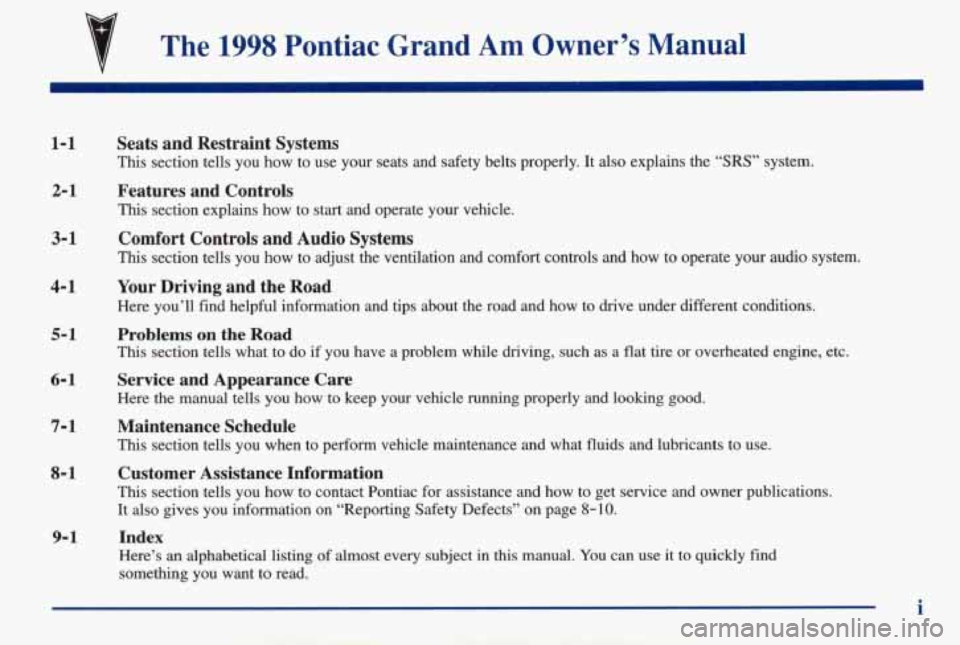
The 1998 Pontiac Grand Am Owner’s Manual
1-1
2-1
3-1
4-1
5-1
6- 1
7-1
8- 1
Seats and Restraint Systems
This section tells you how to use your seats and safety belts properly. It also explains the “SRS” system.
Features and Controls
This section explains how to start and operate your vehicle.
Comfort Controls and Audio Systems
This section tells you how to adjust the ventilation and comfort co\
ntrols and how to operate your audio system.
Your Driving and the Road
Here you’ll find helpful information and tips about the road\
and how to drive under different conditions.
Problems on the Road
This section tells what to do if you have a problem while driving,\
such as a flat tire or overheated engine, etc.
Service and Appearance Care
Here the manual tells you how to keep your vehicle running properly and looking good.
Maintenance Schedule
This section tells you when to perform vehicle maintenance and what fluids and lubrica\
nts to use.
Customer Assistance Information
This section tells you how to contact Pontiac for assistance and ho\
w to get service and owner publications.
It also gives you information on “Reporting Safety Defects” on page
8-10.
9-1 Index
Here’s an alphabetical listing of almost every subject in th\
is manual. You can use it to quickly find
something you want to read.
i
Page 3 of 370
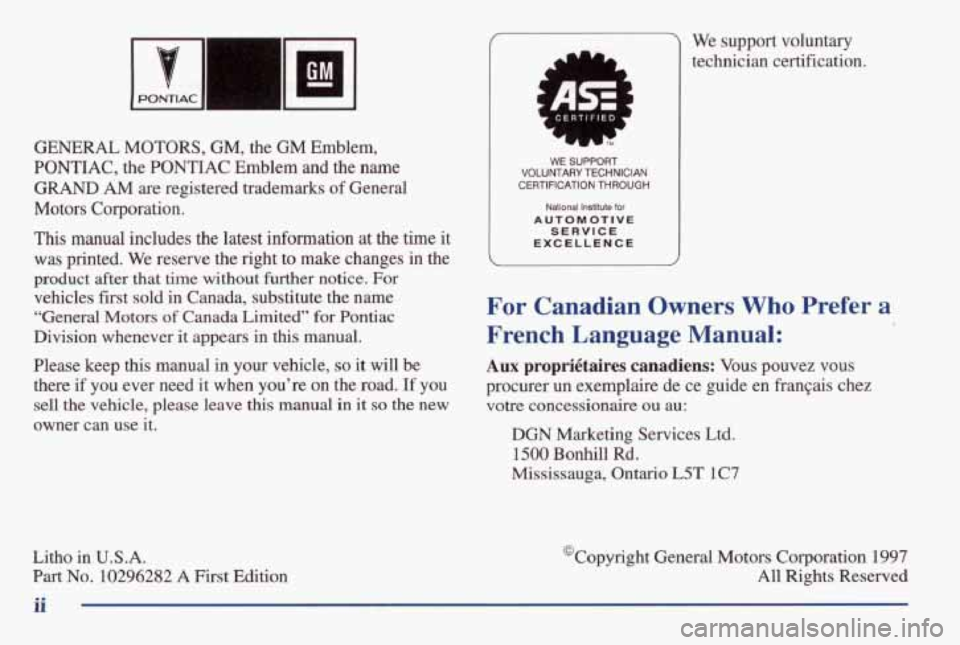
GENERAL MOTORS, GM, the GM Emblem,
PONTIAC, the PONTIAC Emblem and the name
GRAND AM are registered trademarks of General
Motors Corporation.
This manual includes the latest information at the time it was printed.
We reserve the right to make changes in the
product after that time without further notice. For vehicles first sold in Canada, substitute the name
“General Motors
of Canada Limited” for Pontiac
Division whenever
it appears in this manual.
Please keep this manual in your vehicle,
so it will be
there
if you ever need it when you’re on the road. If you
sell the vehicle, please leave this manual in it so the new
owner can use it.
Litho
in U.S.A.
Part No. 10296282 A First Edition
WE SUPPORT VOLUNTARY TECHNICIAN
CERTIFICATION THROUGH
National Institute for
AUTOMOTIVE SERVICE EXCELLENCE
We support voluntary
technician certification.
For Canadian Owners Who Prefer a
French Language Manual:
Aux propriCtaires canadiens: Vous pouvez vous
procurer un exemplaire de ce guide en fraqais chez
votre concessionaire
ou au:
DGN Marketing Services Ltd.
1500 Bonhill Rd.
Mississauga, Ontario
L5T IC7
@Copyright General Motors Corporation
1997
All Rights Reserved
Page 33 of 370
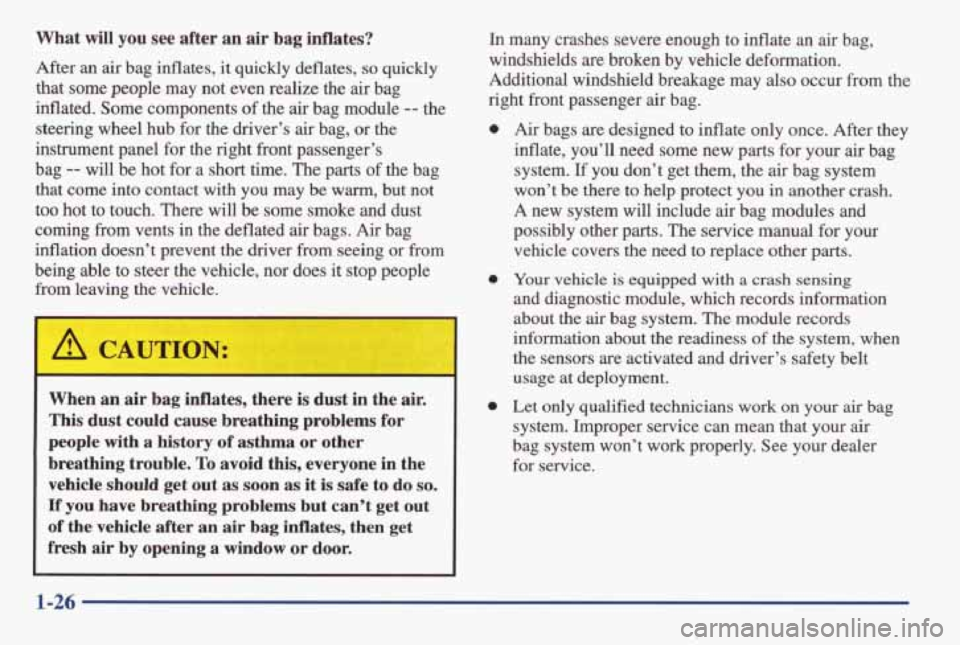
What will you see after an air bag inflates?
After an air bag inflates, it quickly deflates, so quickly
that some people may not even realize the
air bag
inflated. Some components of the
air bag module -- the
steering wheel hub for the driver’s
air bag, or the
instrument panel for the right front passenger’s
bag
-- will be hot for a short time. The parts of the bag
that come into contact with you may be
warm, but not
too hot to touch. There will be some smoke and dust
coming from vents
in the deflated air bags. Air bag
inflation doesn’t prevent the driver from seeing or from
being able to steer the vehicle, nor does it stop people
from leaving
the vehicle.
I
CAUTION:
I
When an air bag inflates, there is dust in the air.
This dust could cause breathing problems for
people with
a history of asthma or other
breathing trouble. To avoid
this, everyone in the
vehicle should get out as soon
as it is safe to do so.
If you have breathing problems but can’t get out
of the vehicle after an air bag inflates, then get
fresh air by opening a window or door.
In many crashes severe enough to inflate an air bag,
windshields are broken by vehicle deformation.
Additional windshield breakage may
also occur from the
right front passenger
air bag.
0
0
Air bags are designed to inflate only once. After they
inflate, you’ll need some new parts for
your air bag
system.
If you don’t get them, the air bag system
won’t be there
to help protect you in another crash.
A new system will include air bag modules and
possibly other parts.
The service manual for your
vehicle covers the need
to replace other parts.
Your vehicle is equipped with a crash sensing
and diagnostic module, which records information
about the
air bag system. The module records
information about the readiness of the system, when
the sensors are activated and driver’s safety belt
usage
at deployment.
Let only qualified technicians work
on your air bag
system. Improper service can mean that your
air
bag system won’t work properly. See your dealer
for service.
1-26
Page 34 of 370
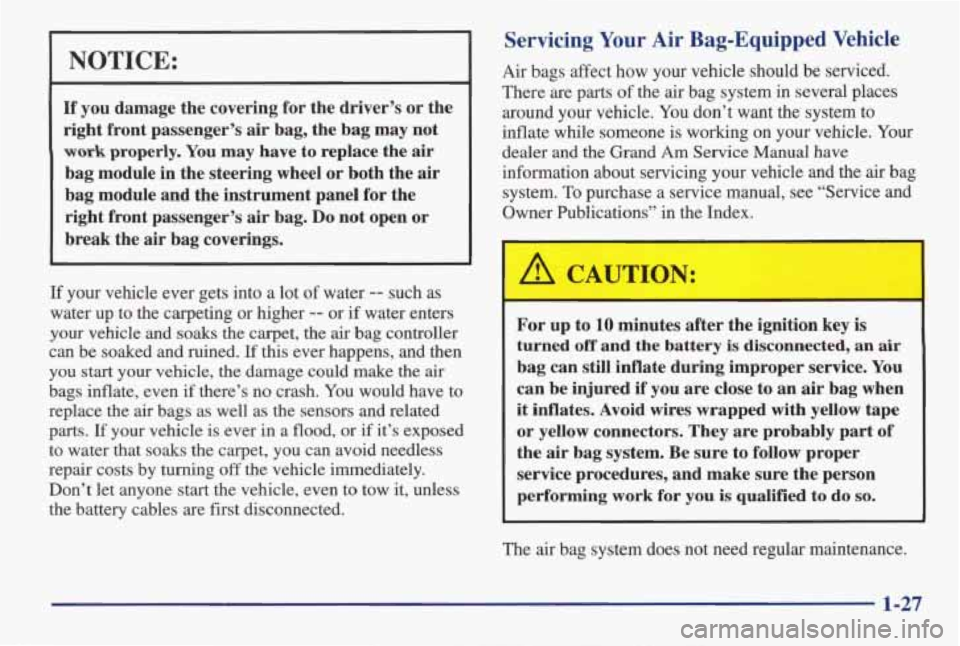
NOTICE:
If you damage the covering for the driver’s or the
right front passenger’s air bag, the bag may not
work properly. You may have to replace the air
bag module in the steering wheel or both the air
bag module and the instrument panel for the
right front passenger’s air bag. Do not open or
break the air bag coverings.
If your vehicle ever gets into a lot of water -- such as
water up to the carpeting or higher
-- or if water enters
your vehicle and
soaks the carpet, the air bag controller
can be soaked and ruined. If this ever happens, and then
you
start your vehicle, the damage could make the air
bags inflate, even if there’s no crash. You would have to
replace the air bags as well as the sensors and related
parts.
If your vehicle is ever in a flood, or if it’s exposed
to water that soaks the carpet, you can avoid needless
repair costs by turning
off the vehicle immediately.
Don’t let anyone start the vehicle, even to tow it, unless
the battery cables are first disconnected.
Servicing Your Air Bag-Equipped Vehicle
Air bags affect how your vehicle should be serviced.
There are parts of the air bag system in several places around your vehicle. You don’t want the system to
inflate while someone
is working on your vehicle. Your
dealer and the Grand Am Service Manual have
information about servicing your vehicle and the air bag system.
To purchase a service manual, see “Service and
Owner Publications” in the Index.
n I
1 A CAUTION:
For up to 10 minutes after the ignition key is
turned off and the battery is disconnected, an air
bag can still inflate during improper service. You
can be injured
if you are close to an air bag when
it inflates. Avoid wires wrapped with yellow tape
or yellow connectors. They are probably part of
the air bag system. Be sure to follow proper
service procedures, and make sure the person
performing
work for you is qualified to do so.
The air bag system does not need regular maintenance.
I
1-27
Page 69 of 370

This system has a range of about 3 feet (1 m) up to
30 feet (9 m). At times you may notice a decrease in
range.
This is normal for any keyless entry system. If
the transmitter does not work or if you have to stand
closer to your vehicle for the transmitter to work,
try this:
0
0
0
0
Check to determine if battery replacement or
synchronization is necessary. See the instructions
that follow.
Check the distance. You may be too far from your
vehicle. You may need to stand
closer during rainy
or snowy weather.
Check the location. Other vehicles or objects may be
blocking the signal. Take a few steps to the
left or
right, hold the transmitter higher, and
try again.
If you’re still having trouble, see your dealer or a
qualified technician for service.
Operation
The following functions are available with the keyless
entry system:
LOCK: All doors will automatically lock when the
LOCK button on the transmitter is pressed. The interior
lamps stay on for a few seconds after all of the doors
are closed.
UNLOCK: The driver’s door will unlock automatically
when the UNLOCK button on the transmitter is pressed.
If the UNLOCK button is pressed again within
five
seconds, all remaining doors will unlock. The interior
lamps will stay on for
40 seconds or until the ignition is
turned on.
Trunk Release: The
trunk will unlock anytime the
vehicle symbol on the transmitter is pressed and the
ignition is
OFF. If the ignition is on, the trunk will
unlock if the parking brake is set (manual transaxle)
or
the gear selector is in PARK (P) or NEUTRAL (N)
(automatic transaxle). The interior lamps will come on
for
40 seconds or until the ignition switch is turned to
the
ON position.
2-8
Page 76 of 370
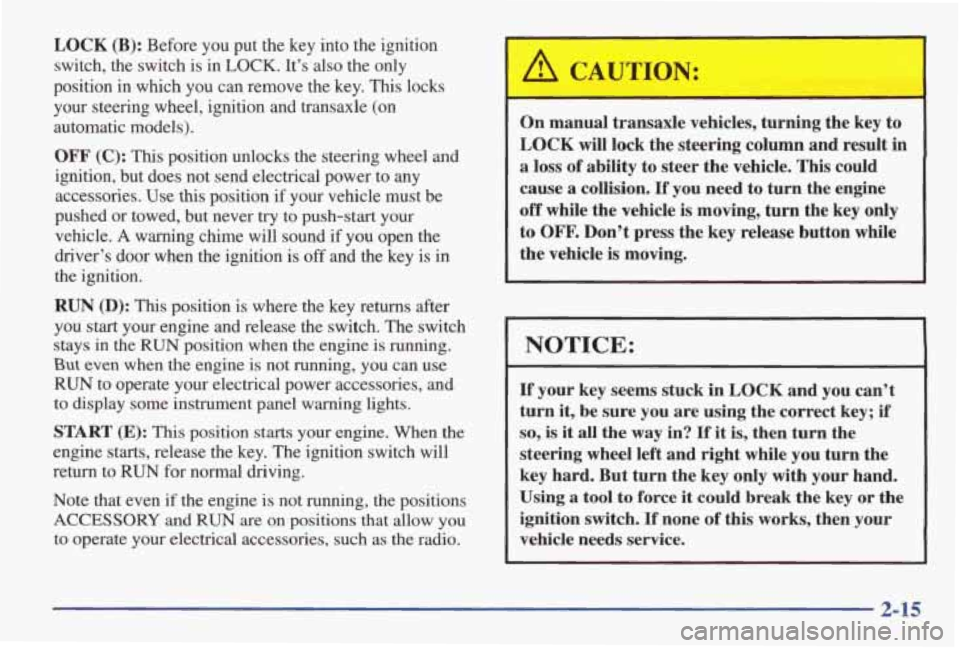
LOCK (B): Before you put the key into the ignition
switch, the switch is in
LOCK. It’s also the only
position in which you can remove the key. This locks
your steering wheel, ignition and transaxle (on automatic models).
OFF (C): This position unlocks the steering wheel and
ignition, but does not send electrical power to any
accessories.
Use this position if your vehicle must be
pushed or towed, but never
try to push-start your
vehicle.
A warning chime will sound if you open the
driver’s door when the ignition is
off and the key is in
the ignition.
RUN @): This position is where the key returns after
you
start your engine and release the switch. The switch
stays
in the RUN position when the engine is running.
But even when the engine is not running, you can use
RUN to operate your electrical power accessories, and
to display some instrument panel warning lights.
START (E): This position starts your engine. When the
engine starts, release the key. The ignition switch
will
return to RUN for normal driving.
Note that even if the engine is not running, the positions
ACCESSORY and RUN are on positions that allow you
to operate your electrical accessories, such as the radio.
On manual transaxle vehicles, turning the key to
LOCK will lock the steering column and result
in
a loss of ability to steer the vehicle. This could
cause a collision.
If you need to turn the engine
off while the vehicle is moving, turn the key only
to OFF. Don’t press the key release button while
the vehicle is moving.
NOTICE:
If your key seems stuck in LOCK and you can’t
turn it, be sure you are using the correct key; if
so, is it all the way in? If it is, then turn the
steering wheel left and right while you turn the
key hard. But turn the key only with your hand.
Using a tool to force it could break the key or the
ignition switch.
If none of this works, then your
vehicle needs service.
2-15
Page 199 of 370
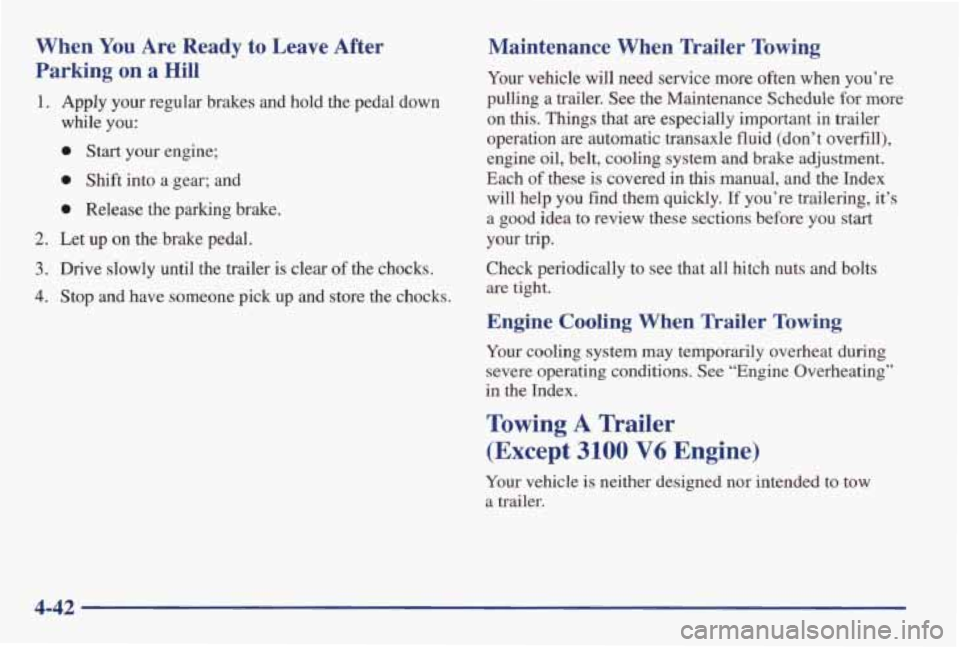
When You Are Ready to Leave After
Parking on a Hill
1. Apply your regular brakes and hold the pedal down
while you:
0 Start your engine;
0 Shift into a gear; and
0 Release the parking brake.
2. Let up on the brake pedal.
3. Drive slowly until the trailer is clear of the chocks.
4. Stop and have someone pick up and store the chocks.
Maintenance When Trailer Towing
Your vehicle will need service more often when you’re
pulling a trailer. See the Maintenance Schedule
for more
on this. Things that are especially important in trailer
operation are automatic transaxle fluid (don’t overfill),
engine oil, belt, cooling system and brake adjustment.
Each
of these is covered in this manual, and the Index
will help you find them quickly. If you’re trailering, it’s
a good idea to review these sections before you
start
your trip.
Check periodically to see that all hitch nuts and bolts
are tight.
Engine Cooling When mailer Towing
Your cooling system may temporarily overheat during
severe operating conditions.
See “Engine Overheating’’
in the Index.
Towing A Trailer
(Except
3100 V6 Engine)
Your vehicle is neither designed nor intended to tow
a trailer.
4-42
Page 207 of 370
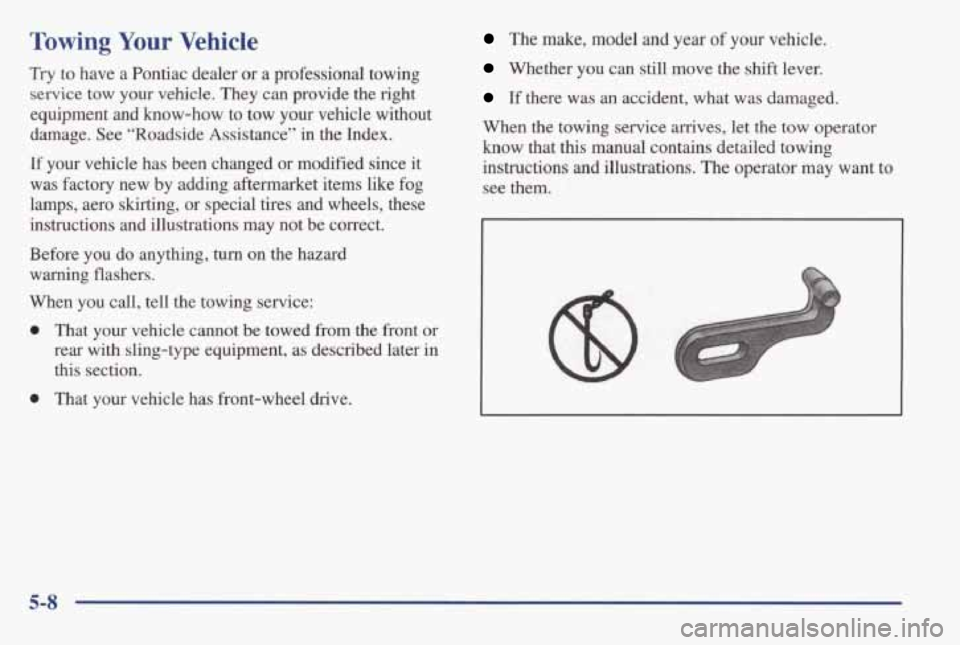
Towing Your Vehicle
Try to have a Pontiac dealer or a professional towing
service tow your vehicle. They can provide the right
equipment
and know-how to tow your vehicle without
damage. See “Roadside Assistance” in
the Index.
If your vehicle has been changed or modified since it
was factory
new by adding aftermarket items like fog
lamps, aero skirting, or special tires and wheels, these
instructions and illustrations may not
be correct.
Before you do anything,
turn on the hazard
warning flashers.
When you call, tell the towing service:
0 That your vehicle cannot be towed from the front or
rear with sling-type equipment, as described later
in
this section.
0 That your vehicle has front-wheel drive.
The make, model and year of your vehicle.
Whether you can still move the shift lever.
If there was an accident, what was damaged.
When the towing service arrives, let
the tow operator
know that
this manual contains detailed towing
instructions and illustrations.
The operator may want to
see them.
5-8
Page 234 of 370
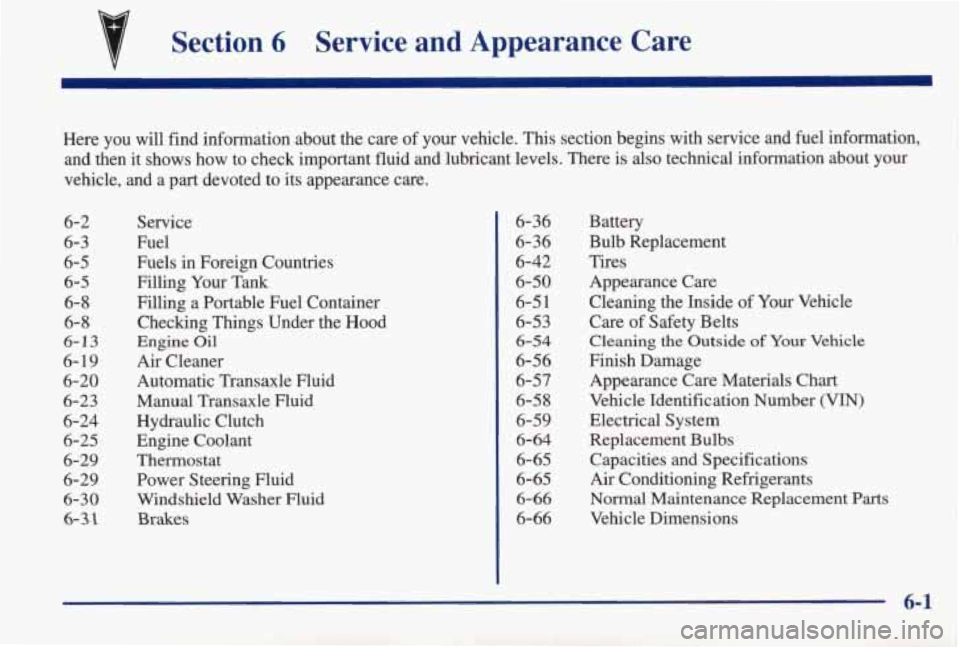
7 Section 6 Service and Appearance Care
Here you will find information about the care of your vehicle. This section begins with service and fuel information,
and then it shows how to check important fluid and lubricant levels. There \
is also technical information about your
vehicle, and a part devoted to its appearance care.
6-2
6-3
6-5
6-5
6-8
6-8
6-13
6-19
6-20
6-23 6-24
6-25
6-29
6-29 6-30
6-31
Service
Fuel
Fuels
in Foreign Countries
Filling
Your Tank
Filling a Portable Fuel Container Checking Things Under the Hood
Engine Oil
Air Cleaner
Automatic Transaxle Fluid
Manual Transaxle Fluid
Hydraulic Clutch
Engine Coolant
Thermostat Power Steering Fluid
Windshield Washer Fluid
Brakes
6-36
6-36
6-42 6-50
6-5
1
6-53
6-54
6-56
6-57
6-58
6-59
6-64
6-65
6-65
6-66 6-66
Battery
Bulb Replacement
Tires
Appearance Care
Cleaning the Inside
of Your Vehicle
Care
of Safety Belts
Cleaning the Outside of Your Vehicle
Finish Damage
Appearance Care Materials Chart
Vehicle Identification Number (VIN)
Electrical System
Replacement Bulbs
Capacities and Specifications Air Conditioning Refrigerants
Normal Maintenance Replacement Parts
Vehicle Dimensions
6-1
Page 235 of 370
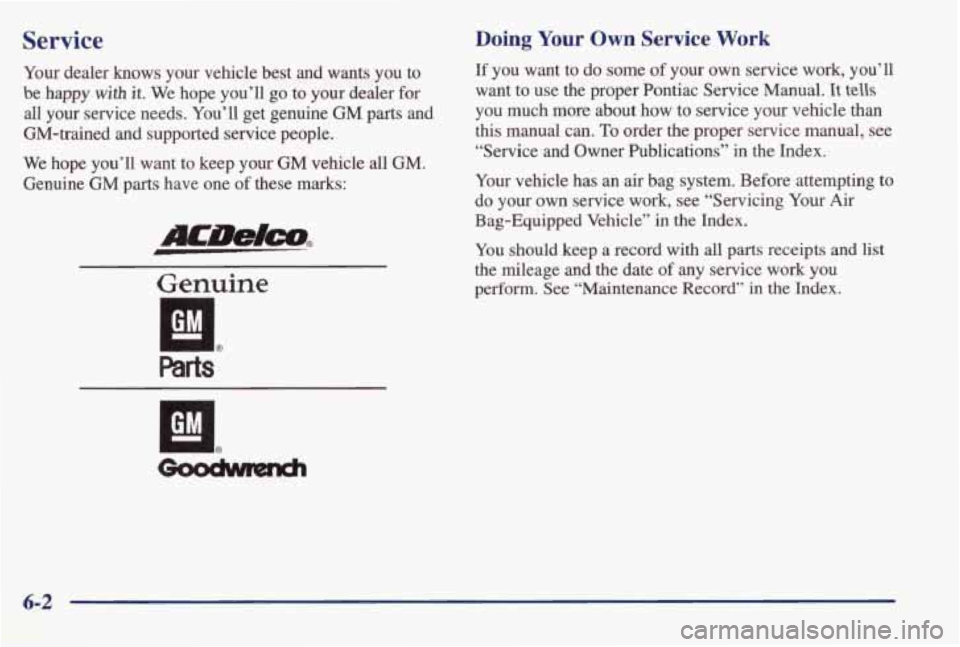
Service
Your dealer knows your vehicle best and wants you to
be happy with it. We hope you’ll go to your dealer for
all your service needs. You’ll get genuine GM parts and
GM-trained
and supported service people.
We hope you’ll want to keep your GM vehicle all GM.
Genuine
GM parts have one of these marks:
Doing Your Own Service Work
If you want to do some of your own service work, you’ll
want to use the proper Pontiac Service Manual.
It tells
you much more about how to service your vehicle than
this manual can. To order the proper service manual, see
“Service and Owner Publications” in the Index.
Your vehicle has an
air bag system. Before attempting to
do your own service work, see “Servicing Your
Air
Bag-Equipped Vehicle” in the Index.
You should keep a record with
all parts receipts and list
the mileage
and the date of any service work you
perform. See “Maintenance Record” in the Index.
6-2